
The glaucophytes, also known as glaucocystophytes or glaucocystids, are a small group of freshwater unicellular algae, less common today than they were during the Proterozoic. Only 15 species have been described, but more species are likely to exist. Together with the red algae (Rhodophyta) and the green algae plus land plants, they form the Archaeplastida. However, the relationships among the red algae, green algae and glaucophytes are unclear, in large part due to limited study of the glaucophytes.

The chlorarachniophytes are a small group of exclusively marine algae widely distributed in tropical and temperate waters. They are typically mixotrophic, ingesting bacteria and smaller protists as well as conducting photosynthesis. Normally they have the form of small amoebae, with branching cytoplasmic extensions that capture prey and connect the cells together, forming a net. They may also form flagellate zoospores, which characteristically have a single subapical flagellum that spirals backwards around the cell body, and walled coccoid cells.
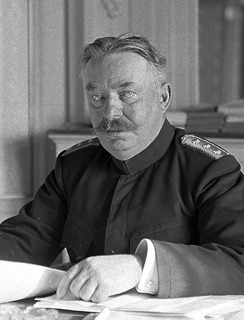
Conrad Ulrich Sigmund Wille was the General of the Swiss Army during the First World War. Inspired by the Prussian techniques that he had been able to observe at the time of his studies in Berlin, he attempted to impress the Swiss Army with a spirit based on instruction, discipline and technical control.
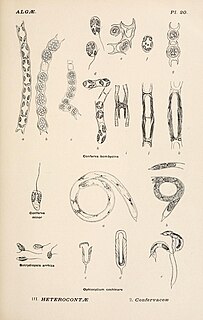
Yellow-green algae or the Xanthophyceae (xanthophytes) are an important group of heterokont algae. Most live in fresh water, but some are found in marine and soil habitats. They vary from single-celled flagellates to simple colonial and filamentous forms. Xanthophyte chloroplasts contain the photosynthetic pigments chlorophyll a, chlorophyll c, β-carotene, and the carotenoid diadinoxanthin. Unlike other heterokonts, their chloroplasts do not contain fucoxanthin, which accounts for their lighter colour. Their storage polysaccharide is chrysolaminarin. Xanthophyte cell walls are produced of cellulose and hemicellulose. They appear to be the closest relatives of the brown algae.
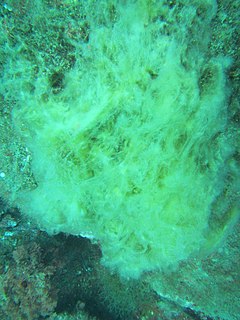
Pelagophyceae is a class of heterokont algae. It is the sister group of Dictyochophyceae.

Eustigmatophytes are a small group of eukaryotic algae that includes marine, freshwater and soil-living species.
Dictyochloropsis is a genus of unicellular green alga of the phylum Chlorophyta. This genus consists of free-living algae which have a reticulate (net-like) chloroplast that varies slightly in morphology between species, and that when mature always lacks a pyrenoid. Dictyochloropsis is asexual and reproduces using autospores.
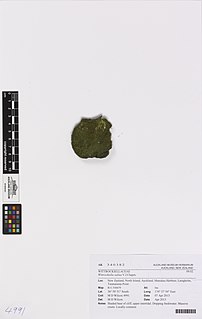
Wittrockiella is a genus of green algae in the family Pithophoraceae. This genus was first described by Nordal Wille in 1909.
Chlorokybus is a multicellular (sarcinoid) genus of basal green algae or Streptophyte containing the sole species Chlorokybus atmophyticus, a soil alga found in alpine areas. It sometimes has been classified as the sole member of the class ChlorokybophyceaeSluiman & Guihal, 1999.
Wille Mäkelä is a Finnish curler and Olympic medalist. He received a silver medal at the 2006 Winter Olympics in Torino.
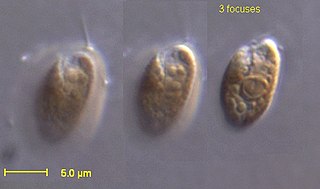
Rhodomonas is a genus of cryptomonads.
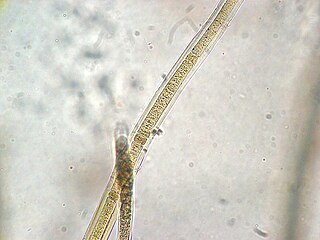
Scytonema is a genus of photosynthetic cyanobacteria that contains over 100 species. It grows in filaments that form dark mats. Many species are aquatic and are either free-floating or grow attached to a submerged substrate, while others species grow on terrestrial rocks, wood, soil, or plants. Scytonema is a nitrogen fixer, and can provide fixed nitrogen to the leaves of plants on which it is growing. Some species of Scytonema form a symbiotic relationship with fungi to produce a lichen.
Lothar Geitler was an Austrian botanist and cytologist. He was born in Vienna. His main research interests included blue-green algae (Cyanophyta), diatoms, lichen symbioses and chromosome structure. The genus Geitlerinema was named in his honour.
Spirulina agilissima is a freshwater cyanobacteria from the genus Spirulina.
Kohlrosing is the Scandinavian tradition of incising thin decorative lines and patterns in carved wood and filling with dark powders or colored wax, etc. for contrast,. Kohlrosing dates back to at least Viking times.
Gloeocapsopsis is a genus of cyanobacteria belonging to the family Chroococcaceae.
Goniochloris is a genus of Chromista belonging to the family Pleurochloridaceae.
Cyanodictyon is a genus of cyanobacteria belonging to the family Synechococcaceae.
Heteroleibleinia is a genus of algae belonging to the family Pseudanabaenaceae.
Lemmermanniella is a genus of cyanobacteria belonging to the family Synechococcaceae.








